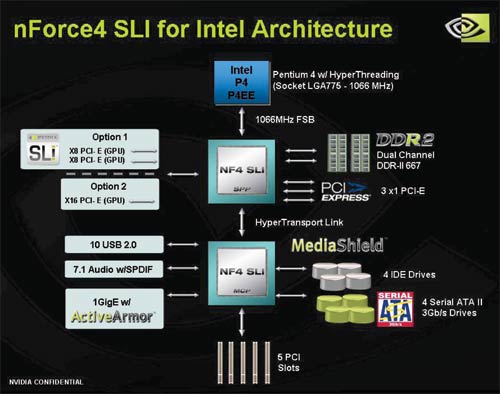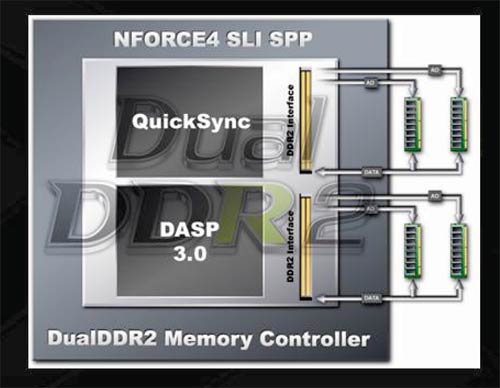Dual Core Intel Platform Shootout - NVIDIA nForce4 vs. Intel 955X
by Anand Lal Shimpi on April 14, 2005 1:01 PM EST- Posted in
- CPUs
NVIDIA's nForce4 SLI Intel Edition Chipset
As we've indicated in the past, NVIDIA's first Intel chipset is very similar to their nForce4 AMD chipset, with a couple of exceptions. For starters, the Intel Edition chipset is made up of two chips, compared to the AMD chipset's one. The reasoning is simple: with AMD's architecture, NVIDIA needn't include a memory controller in their chipset, which cuts down on overall die size quite a bit. With the Intel Edition, we see the first new memory controller that NVIDIA has introduced since nForce2.

Remember DASP? NVIDIA's Dynamic Adaptive Speculative Pre-Processor is back in nForce4 Intel Edition, but this time around, the competition is much stronger. DASP is a hardware pre-fetch engine that resides within the memory controller and attempts to pre-fetch data into a small amount of cache on the chipset, which NVIDIA's algorithms determine will be used by the CPU in the future. Intel has a similar technology in their 955X chipset, although it's not something they have branded or marketed. Depending on how aggressive NVIDIA's DASP is, it could make good use of the extra memory bandwidth offered by its dual channel DDR2-533/667 memory bus.

NVIDIA also boasts a dedicated address bus per DIMM slot with the nForce4; however, this seems to be a feature also supported by Intel, so there isn't much advantage over the competition here.
In their final memory controller optimization, NVIDIA's QuickSync claims to be able to reduce memory latency when operating in multiple clock domains (e.g. 800MHz FSB, but 533MHz memory bus). Later in this article, we'll find out exactly how aggressive NVIDIA's memory controller truly is.
The nForce4 SLI Intel Edition chipset supports both 800 and 1066MHz FSBs, just like the 955X - however, NVIDIA also indicated that if Intel were to increase the FSB frequency, they would be ready.
Unlike the 955X, NVIDIA only supports 3 PCI Express x1 slots. However, NVIDIA does offer two PATA channels, compared to Intel's single PATA channel. NVIDIA also offers more USB 2.0 ports (10 vs 8). NVIDIA does not support Intel's HD Audio spec, so you're stuck with AC'97 on the nForce4 SLI.










96 Comments
View All Comments
Anand Lal Shimpi - Thursday, April 14, 2005 - link
whoa whoa, I'm no deity here, just a normal guy like everyone else - I can make mistakes and I encourage everyone to never blindly follow something I, or anyone else, says. That being said, Questar I've got a few things that you may be interested in reading:1) http://images.anandtech.com/graphs/pentium%204%206...
That graph shows exactly how hot Prescott gets, in fact, until the release of the latter 5xxJ series and 6xx series with EIST, Prescott systems were considerably louder than Athlon 64 systems. "Too hot" may be an opinion, but it's one echoed by the vast majority of readers as well as folks in the industry - who, in turn, are the ones purchasing/recommending the CPUs so their opinion matters quite a bit.
2) NVIDIA changed the spelling of their name from nVidia to NVIDIA a few years ago, have a look at NVIDIA's home page for confirmation - http://www.nvidia.com/page/companyinfo.html
3) I can't go into specifics as to how the Intel/NVIDIA agreement came into play, but know that Intel doesn't just strike up broad cross licensing agreements to companies like NVIDIA so they can make money on NVIDIA's chipsets. The Intel/NVIDIA relationship is far from just a "you can make chipsets for our CPUs" relationship, it is a cross licensing agreement where Intel gets access to big hunks of NVIDIA's patent portfolio and NVIDIA gets access to Intel's. That sort of a play is not made just to increase revenues, I can't go into much further detail but I suggest reading up on patent law and how it is employed by Intel.
4) Also remember that Intel not manufacturing silicon isn't necessarily a cost saver for them; a modern day fab costs around $2.5B, and you make that money back by keeping the fab running at as close to capacity as possible.
I think that's it, let me know if I missed something. I apologize for not replying earlier, I've been extremely strapped for time given next week's impending launch.
Houdani
I haven't played around with all of the multitasking tests, but I'd say that the lighter ones (I/O wise) have around 8 - 10 outstanding IOs. I believe NVIDIA disables NCQ at queue depths below 32, but I don't think Intel does (which is why Intel shows a slight performance advantage in the first set of tests).
Interestingly enough, in the first gaming multitasking scenario, Intel actually ends up being faster than NVIDIA by a couple of percent - I'm guessing because NVIDIA is running with NCQ disabled there.
Take care,
Anand
Questar - Thursday, April 14, 2005 - link
"I can only hope that you are not working for an IT company."Missed that.
I do not work for an IT company, but I do work in the IT industry.
In 2005 I will purchase 11,500 desktop/notebook systems, and 900-975 servers.
Questar - Thursday, April 14, 2005 - link
"It's pretty clear - Intel's last few products have been worthless in many cases."Once again you show your onw ignorance. Worthless means having no value. If the products were worthless then Intel wouldn't have such a large share of the market.
You will someday learn about business grasshopper :).
Time for me to go home for the night boys, have a good night!
overclockingoodness - Thursday, April 14, 2005 - link
#31: I agree with you 100 percent..overclockingoodness - Thursday, April 14, 2005 - link
#29 segagenesis: He isn't going to believe the popular sites because he thinks they are bought out and their editors have no knowledge of the industry. And if you find a smaller site, he still won't believe you because smaller sites know nothing either.Questar: Do you think you are the only with industry knowledge? I can only hope that you are not working for an IT company.
segagenesis - Thursday, April 14, 2005 - link
#28 - Just to keep things balanced here, Intel has a large portion of the OEM market because it can produce products in volume compared to AMD and most people dont really care whats "Intel Inside" thier computer. Just beacuse AMD may have a technologically superior processor doesnt mean its going to do wonders overnight when you just have to cite Betamax vs. VHS. On the other hand, Intel has the Pentium-M which is a good piece of hardware yet is limiting its market penetration with high prices/low production.overclockingoodness - Thursday, April 14, 2005 - link
#26 QUESTAR: I see you can't handle the proof, eh. After you couldn't come up with a counter-argument you decided to bash Toms. Sure, Toms may not be as in-depth as Anand and they could be biased, but they aren't that blatant about it.At least Toms is better than you.
Like I said, why don't you just get lost?
segagenesis - Thursday, April 14, 2005 - link
#26 - What I cant provide links outside this site because they dont count? Oh wait this site doesnt "count" either does it?Regarding the infamous AMD video that was a long time ago, not to mention Tom's doing such a video actually made something HAPPEN in the industry. AMD responded and added thermal protection in the newer CPUs. The P4 heat problem is *now*!
overclockingoodness - Thursday, April 14, 2005 - link
#25 QUESTAR: "Let me explain it to you:Intel get's a cut of the money from every chipset nVidia sells. What part of that don't you get?"
Is it better for Intel to get a cut out of NVIDIA's profits or hog the entire market with their own chipsets and take all the profits to themselves? What I don't get is how stupid you are.
"Ummm...yeah right, go right on thinking that."
Yet again, we have a mornoic statement from our AnandTech's very own dumbass. Maybe Anand should hire you to post stupid comments throughout the site to generate more discussions. Then again, even he will get tired seeing your stupid comments.
Intel surely doesn't have a chance against AMD with their Prescott CPUs. The only reason Intel is still the number one chipmaker is because it has signed exclusive contracts with Dell and Sony and there are quite a few people out there who could care less if they have an Intel or AMD CPUs.
Once again, it's your own ignorance that's blocking your thinking passages. Neither AMD nor Intel are strong enough take each other out of the business, but AMD CPUs do perform better in many scenarios against Intel CPUs. This include both desktop as well as server level CPUs. If you remember the article on AnandTech, Opteron kicked Intel's ass. And with the new Opterons coming soon, you will get a confirmation yourself.
It's pretty clear - Intel's last few products have been worthless in many cases.
segagenesis - Thursday, April 14, 2005 - link
#24 - I dont mind because I deal with people like him every day. I have used AMD myself for the past 5 years but I will admit that Intel has the performance crown lately when it comes to content encoding... however at a price. I have also preferred AMD due to pricing and gaming performance where it continues to do fairly well at.Working in labs maintaing them as is desktops (I am responsible for about 500+ computers) I have noticed that with newer P4's the heat output is actually noticeable. As I said a whole room full of them really raise the themperature, and thats just sitting there idle. A friend of mine has a 3.8ghz P4 and that thing is at its thermal limit with a X850 XT PE in the same case. Ouch!